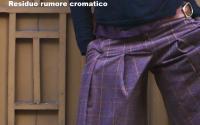
In some zones of the image, mostly in sharpen edges or where the noise is more intense, Noise Ninja leaves behind some chromatic noise.
Talking with Claudio Muzzetto about the article Local techniques of sharpening and noise reduction, we noticed the possibility of another passage that completely eliminates every kind of chromatic noise. The technique is used to reduce the color fringing, (colored halos between lights and shadows, generally due to chromatic aberrations), but can be successfully used to filter the chromatic noise. Once again, I suggest to download the images and observe them 100% zoom to notice the real effects obtained with the described technique.
(more…)
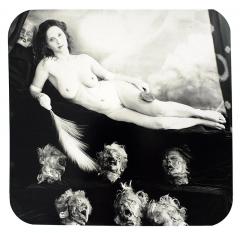
Ars Moriendi, 2007. Analogical print 68.5×67.5cm, 12 copies edition.
© Joel-Peter Witkin
It’s been some months since I started thinking about a new category of articles for Camera Obscura, something like “around a photograph”. A category with a series of articles, each one dedicated to an image, a particular picture, which came into my life and there it stayed, such a rock in the middle of a street. One of that pictures that astonishes, that leaves you dumbfounded. It could be love, repulsion, impression and envy, no matter what. They will be with me for the rest of my life, with their emotional and visual strength, never leaving me. I’m talking about rare images, pictures that become rarer and rarer the more boredom and knowledge pollute the astonishment on which we are looking at the world.
(more…)
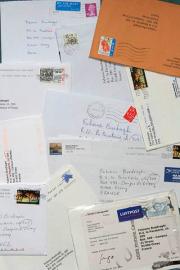
Some of the envelopes received during the annual exchange of pinhole pictures.
Since 2001 some pinhole photography lovers created the Pinhole Cards Exchange, which means exchanging pinhole pictures or more generally pictures realized without any lens (that is zone plate, pinhole slits, multi-holes, etc…) in occasion of the new year. In practical terms, the members add their address to a list, they can send one or a dozen of pictures, for free and without any specific rule, apart that the picture must be obtained without the use of a lens. Christmas and wishes are not my problem, but I gladly participated, and I must say that I was pleased to receive almost a letter per day, when everything arrives on the net and spot or bank bills are the only thing inside the mailbox. No way to explain the pleasure to see different envelopes, letter or print paper.
(more…)
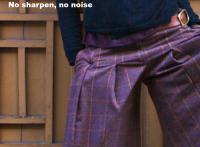
Original image, with exposition and contrast correction but no intervention of sharpening and noise reduction.
Concerning analogical photography, once fixed the negative enlarger factor, the detail of a print is principally determined by a good shooting technique (absence of micro blur, correct focusing, correct depth of field and so on) and the resolving power of the shooting objective and the one on the enlarger. The image grain is determined by the film choice, exposition and development. Moreover the development allows controlling the acutance of the image. Furthermore, during the print phase, it is possible to modify both the detail and the picture grain, for example using contrast masks or out-of-focusing some zones with pantyhose interposed between the objective and the enlarger plan, but the interventions are long, laborious, hard to perform and have a somehow limited impact on the acutance and the image grain.
(more…)

Flatiron © Edward Steichen
The first European retrospective of Edward Steichen has been presented during the last months of 2007 at the Jeu de Paume in Paris. It was an exhibition I had to visit because, even if I knew the most famous images of Steichen, I barely saw his original works of his first pictorialist years. Moreover, the 450 photos that were part of the exhibition were a sure promise to deepen the knowledge of one of the most prolific and incisive photographer of the last century.
The exhibition starts, as expected, with the first pictorialist pictures of the beginning of the long Steichen career. I deeply looked all the pictures from the technique side, as I am an insider and a printer of antique techniques, even if I didn’t forget the aesthetic side.
(more…)
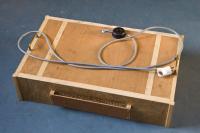
UV tubes box for alternative print techniques.
The majority of alternative and antique techniques use material that is sensitive to UV radiation but not to visible light. Moreover almost all the supports are slower than the usual silver nitrate paper. Therefore, it is not possible to use a simple enlarger as in dark room. It is necessary to use a big UV light source and print by contact using a printing frame to obtain the perfect contact between negative and print support.
(more…)
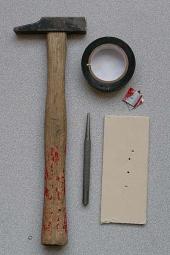
Instruments needed to mount a pinhole diaphragm on a support slide.
The electronic microscope diaphragms are splendid pinhole of perfectly known and regular diameter, but they are small (circular 3mm slides) and they have to be mounted on bigger support slide not to ruin them and to use them more easily. This article will expose some suggestions that will let you mount them in an easy and efficient way. The holes are not sold mounted as the exigencies of every photographer could vary.
The necessary currency material: an aluminum tin can, some black adhesive tape (the one used by electricians) and an instrument to make 2mm holes. If you got a drill and a 2mm drill bit, well you got the whole! But unfortunately not everyone has a little workshop in its house. I procured a 2mm punch, which is 1,50 euros in any ironmonger’s. I think that everyone has a hammer in its house, as well as a piece of compact cardboard that will be your pad, therefore the expense to get everything you need is quite contained.
(more…)
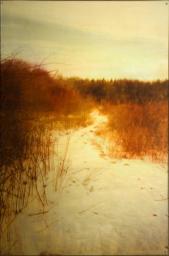
Snowpath, 2007.
© Dorothy Simpson Krause
Dorothy Simpson Krause is an American artist who works mainly with collage, combining traditional materials with digital techniques.
She is not a photographer, but she makes intensive use of photography in her collage. Typically her work would be considered non-photographic, and classified under some form of visual art but not “Photography”. For a long time I have been tried to convince photographers that the border between photographic image and other visual arts is not as sharp and it is not easy to determine what photography is and what is not. Indeed, the question itself has no real sense, because photography is an ambiguous media, photography is actually a term commonly used to group practices also substantially different between them. For this reason I’m happy to have on Camera Obscura such an artist, that move the border of photo art.
(more…)











